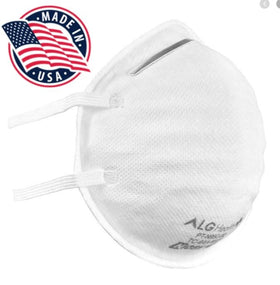
N95 and KN95 Masks for California Wildfires: What to Know?
Residents of Los Angeles County impacted by the recent wildfires are encouraged to use proper masks to safeguard against harmful smoke exposure.
Health professionals emphasize that N95 respirator masks provide the highest level of protection when they are properly fitted and worn correctly. These masks are widely available at hardware stores and pharmacies and are designed to filter out fine particles commonly found in smoke. Also KN95 respirator masks provide nearly the same level of protections with the main difference being they attach behind the ears versus behind the head which many people prefer. These particles can irritate the eyes, nose, throat, and lungs, according to public health officials. However, it is important to note that N95 masks do not guard against hazardous gases that may also be present in wildfire smoke.
The New York City Health Department advises wearing masks in areas with poor outdoor air quality, such as the current conditions in Los Angeles County. Symptoms like coughing, throat irritation, and eye discomfort are often associated with exposure to air pollution. Wearing a properly fitted mask can help minimize these symptoms, according to health experts.
To maximize protection, masks must be worn snugly, covering the nose, mouth, and chin. A poorly fitted mask offers little to no filtration and can give a false sense of security. Additionally, ensuring the use of the appropriate mask type is crucial for effective protection. Health officials caution that single-strap paper dust masks, surgical masks, bandanas, or towels (whether wet or dry) do not adequately protect against wildfire smoke. While such coverings may help with dryness, they do not shield the lungs from harmful particles.
People with lung or heart conditions or chronic illnesses should consult a healthcare provider before using a mask. Respirator masks can make breathing more difficult and may cause discomfort if worn for extended periods.
N95 masks are capable of filtering out 95% of fine particles, while N90 masks provide 90% protection against pollutants. For optimal effectiveness, masks should be certified by the National Institute for Occupational Safety and Health (NIOSH), which is indicated by specific printed markings on authentic products. For even greater filtration, N100 or P100 masks can block up to 99.7% of particles but may make breathing more challenging, according to Dr. William Lang, chief medical officer at WorldClinic and former director of the White House Medical Unit. If N95 masks are unavailable, KN95 masks offer comparable protection against wildfire-related particles.
Air quality levels can determine whether wearing a mask is necessary. The Air Quality Index (AQI) is a numerical scale that measures and reports outdoor air quality. It assesses air pollution levels and their potential impact on human health. According to Parcil Safety, the AQI tracks common pollutants, including particulate matter (PM2.5 and PM10), ozone (O3), nitrogen dioxide (NO2), sulfur dioxide (SO2), and carbon monoxide (CO). Each pollutant is assigned an index value based on its concentration in the air.
The AQI uses a color-coded system ranging from green (good air quality with minimal health risks) to maroon (hazardous air quality). When the air quality reaches hazardous (maroon) or very unhealthy (purple) levels, there is a heightened risk of severe health effects for everyone.
Health officials recommend that the best protection during smoky conditions is to stay indoors and limit outdoor activities. For those who must go outside, taking frequent breaks is advised, as respirator masks can make breathing more strenuous.


